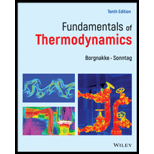
Fundamentals Of Thermodynamics
10th Edition
ISBN: 9781119494966
Author: Borgnakke, C. (claus), Sonntag, Richard Edwin, Author.
Publisher: Wiley,
expand_more
expand_more
format_list_bulleted
Question
error_outline
This textbook solution is under construction.
Students have asked these similar questions
A cycle heat engine does 60KJ of work per cycle. If th efficiency of the heat engine is 60%. The heat rejected per cycle is?
A cycle HE does 60kJ of work per cycle. If the efficiency of the heat engine is 60%. The heat rejected per cycle is.
Suppose 400 kW of power potential is wasted during the process as a result of irreversibility. Let say the heat pump received heat at a rate of 1000 kJ/s from a heat source. The reversible power of the present process is found to be 800 kW. Find unavailable heat, which is rejected to the sink.
Knowledge Booster
Learn more about
Need a deep-dive on the concept behind this application? Look no further. Learn more about this topic, mechanical-engineering and related others by exploring similar questions and additional content below.Similar questions
- I need the answer as soon as possiblearrow_forwardThrough a combustion of a fossil fuel at 35000C, an engine receives energy at a rate of 3000Btu/s to heat a steam to 15000C. There is no energy loss during the combustion process, the steam in turn produces 1000Btu/s of work and rejects the remaining energy to the surrounding at 3000C, What is the thermal efficiency of the plant? What is the reversible work and Carnot efficiency? What is irreversibility?arrow_forwardA reversible heat engine absorbs 3000 kJ from a reservoir at 1000 K and rejects 2500 kJ at 500 K. Find the heat interchanged with the reservoir at 300 K and the net work output of the engine.arrow_forward
- Solve it correctly and fast please.arrow_forwardSteam to a turbine at a mass flow rate of 1.4 kg/s, 700 kPa pressure and 400 °C enters the temperature. Steam at 100 kPa pressure and 1.4 m3/kg specific volume exits the turbine. Heat transfer from turbine to environment 50 kW, with turbine Since the boundary temperature between the environment is 70 °C, a) Find the power produced by the turbine, entropy produced in the turbine and isentropic efficiency of the turbine. Note: The changes in kinetic and potential energies will be neglected and T (K) = 273 + °C will be taken.arrow_forwardA heat engine receives 5 kW at 800 K and 15 kW at 1000 K rejecting energy by heat transfer at 600 K. Assume it is reversible and find the power output, W.?arrow_forward
- A heat engine of 30% efficiency drives a heat pump of COP 5. The heat is transferred both from engine and the heat pump to circulating water for heating the building in winter. Find the ratio of heat transfer to the circulating water from heat pump to the heat transfer to the circulating water from the heatarrow_forward(15%) A small expander (a turbine with heat transfer) has 0.05 kg/s helium entering at 1000 kPa, 550 K and leaving at 250 kPa, 300 K. The power output on the shaft measures 55 kW. Find the rate of heat transfer, neglecting kinetic energies.arrow_forwardA 4 kW 20L water heater is switched on for 10minutes. The heat capacity of water is 4.187 kJ/kgK. Assuming total electrical energy has gone intoheating the water, find the increase in watertemperature.arrow_forward
- The turbine section in a jet engine receives gas (assume air) at 1200 K, 800 kPa with an ambient atmosphere at 80 kPa. The turbine is followed by a nozzle open to the atmosphere and all the turbine work drives a compressor receiving air at 85 kPa, 270 K with the same flow rate. Find the turbine exit pressure P₂ so the nozzle has an exit velocity of 800 m/s.arrow_forwardI need the answer as soon as possiblearrow_forwardDon't copy from any sourcearrow_forward
arrow_back_ios
SEE MORE QUESTIONS
arrow_forward_ios
Recommended textbooks for you
 Elements Of ElectromagneticsMechanical EngineeringISBN:9780190698614Author:Sadiku, Matthew N. O.Publisher:Oxford University Press
Elements Of ElectromagneticsMechanical EngineeringISBN:9780190698614Author:Sadiku, Matthew N. O.Publisher:Oxford University Press Mechanics of Materials (10th Edition)Mechanical EngineeringISBN:9780134319650Author:Russell C. HibbelerPublisher:PEARSON
Mechanics of Materials (10th Edition)Mechanical EngineeringISBN:9780134319650Author:Russell C. HibbelerPublisher:PEARSON Thermodynamics: An Engineering ApproachMechanical EngineeringISBN:9781259822674Author:Yunus A. Cengel Dr., Michael A. BolesPublisher:McGraw-Hill Education
Thermodynamics: An Engineering ApproachMechanical EngineeringISBN:9781259822674Author:Yunus A. Cengel Dr., Michael A. BolesPublisher:McGraw-Hill Education Control Systems EngineeringMechanical EngineeringISBN:9781118170519Author:Norman S. NisePublisher:WILEY
Control Systems EngineeringMechanical EngineeringISBN:9781118170519Author:Norman S. NisePublisher:WILEY Mechanics of Materials (MindTap Course List)Mechanical EngineeringISBN:9781337093347Author:Barry J. Goodno, James M. GerePublisher:Cengage Learning
Mechanics of Materials (MindTap Course List)Mechanical EngineeringISBN:9781337093347Author:Barry J. Goodno, James M. GerePublisher:Cengage Learning Engineering Mechanics: StaticsMechanical EngineeringISBN:9781118807330Author:James L. Meriam, L. G. Kraige, J. N. BoltonPublisher:WILEY
Engineering Mechanics: StaticsMechanical EngineeringISBN:9781118807330Author:James L. Meriam, L. G. Kraige, J. N. BoltonPublisher:WILEY

Elements Of Electromagnetics
Mechanical Engineering
ISBN:9780190698614
Author:Sadiku, Matthew N. O.
Publisher:Oxford University Press

Mechanics of Materials (10th Edition)
Mechanical Engineering
ISBN:9780134319650
Author:Russell C. Hibbeler
Publisher:PEARSON

Thermodynamics: An Engineering Approach
Mechanical Engineering
ISBN:9781259822674
Author:Yunus A. Cengel Dr., Michael A. Boles
Publisher:McGraw-Hill Education

Control Systems Engineering
Mechanical Engineering
ISBN:9781118170519
Author:Norman S. Nise
Publisher:WILEY

Mechanics of Materials (MindTap Course List)
Mechanical Engineering
ISBN:9781337093347
Author:Barry J. Goodno, James M. Gere
Publisher:Cengage Learning

Engineering Mechanics: Statics
Mechanical Engineering
ISBN:9781118807330
Author:James L. Meriam, L. G. Kraige, J. N. Bolton
Publisher:WILEY
Power Plant Explained | Working Principles; Author: RealPars;https://www.youtube.com/watch?v=HGVDu1z5YQ8;License: Standard YouTube License, CC-BY